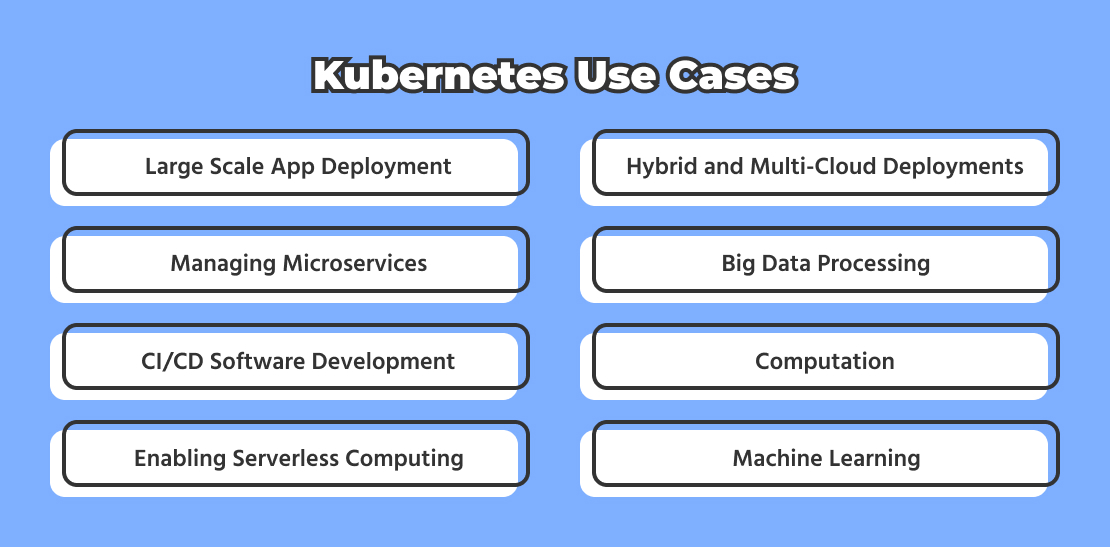Kubernetes Use Cases and Trends
Microservices architecture pattern is one of the most popular approaches used in software development nowadays. Being composed of stand-alone containers smoothly connected with each other, microservices applications are faster to create, simpler to scale, easier to add new features, and much more.
While it’s easy to build a container for a software developer, handling multiple containers and deploying them to various environments can become a real challenge without utilizing special container orchestrating instruments. Google has foreseen this issue long ago and created a robust and effective solution for simple microservices components management – Kubernetes.
We expect that in 2023, Kubernetes will maintain the upper hand in microservices application development. That’s because the technology offers the most consistent and efficient approach to container management and it’s actively developing to remain a real market leader in this niche. In this article, we’ll have a look at how Kubernetes works and find out the Kubernetes adoption trends in 2023.
What Is Kubernetes and Benefits It Provides
Kubernetes is a platform that facilitates microservices container orchestration. This open-source tool created and supported by Google makes it simple to configure, deploy, manage, scale, and monitor containerized applications. Apart from that, it’s also used by software developers for container and application lifecycle management, e.g. load balancing, ensuring the high availability of microservice components, and much more.
Kubernetes isn’t the only option, though it has become a powerful automation solution widely implemented by DevOps teams. Here are the main benefits Kubernetes provides:

- Resource-saving – big and small companies can save many resources used for ecosystem management and significantly speed up software development through the automation of manual processes. Moreover, Kubernetes effectively packs containers into nodes and nodes into clusters, making their handling much simpler with fewer API services involved. The reduction of API services helps to lower costs and ensure better protection from a system malfunction.
- Enhanced DevOps efficiency – Kubernetes significantly simplifies the life of DevOps teams. It automates many of the DevOps lifecycles and simplifies app development, testing, and deployment by ensuring efficient container integration. Now, software developers don’t have to launch a virtual machine to run an application, they can create container images with all the needed components inside for a successful app run instead.
- Multicloud deployment – with Kubernetes, software developers can easily deploy their apps on-premise infrastructure, on a cloud – AWS, Google Cloud, Microsoft Azure, IBM Cloud, or opt for hybrid deployment across several clouds no matter if it’s public or private. Moreover, Kubernetes doesn’t depend on a particular runtime or cloud infrastructure. It means that IT specialists don’t have to re-architect their development environments to adjust them to the Kubernetes services.
- Increased app stability and up-time – Kubernetes monitors and automatically balances workloads in apps. As a result, when the workload rises, Kubernetes scales its clusters to adapt to the increasing demand. This way, it ensures that the app’s work is stable and the system is alive. Moreover, if one of the app clusters fails, Kubernetes will redistribute the workload to other clusters, maintaining app availability for its users. Another great feature of this platform is that it can perform system diagnostics and replace containers if they fail. This reduces the possibility of app downtime to a minimum.
Kubernetes Use Cases
Many businesses and companies utilize Kubernetes in their apps. In 2021, 68% of IT specialists utilized Kubernetes for developing and rolling out their digital solutions. Here are some practical cases of how to effectively implement this tool for building microservice-based apps.

Development of Large-Scale Apps
Kubernetes is a powerful tool for building enterprise-level digital solutions. It facilitates the container management process, allowing for simply bundling and deploying numerous containers. As a result, software developers can use resources more efficiently and better isolate containers and their processes from each other.
Two more reasons to build enterprise apps with Kubernetes are their fast scalability and robustness. By adding more containers or increasing the number of nodes in a cluster, software developers can quickly respond to workload increases, ensuring that the app is functional. Given this, Kubernetes prevents app downtimes due to components’ failure. Even if one of the nodes or a cluster fails, Kubernetes automatically redistributes the workload so that it doesn’t affect the app work and it remains stable.
CI/CD Software Development
Continuous Integration/Continuous Deployment (CI/CD) is one of the basic principles of modern software development and Kubernetes is an important part of this process. It’s used in cloud-native CI/CD pipelines to automate container deployment across cloud infrastructure environments and ensure efficient use of resources.
Many DevOps teams choose Kubernetes for their CI/CD processes for its automation, monitoring, and integration capabilities. It integrates with various tools implemented in CI/CD such as Docker, GitHub, GitLab, Jenkins, a variety of cloud solutions, and many others.
Machine Learning
While analyzing data with Machine Learning (ML) is becoming a widely-implemented strategy for many businesses. Building and developing ML models involves many complex processes such as analysis of large volumes of data, heavy computations, and building effective algorithms based on the detected data patterns. Implementing this process in an application requires much time and resources. That’s why many software developers opt for Kubernetes in their work. Kubernetes helps automate a large number of operations required for effective app deployment with ML and, therefore, shortens time-to-market.
Shifting Apps to a Cloud
With Kubernetes, it becomes much easier and quicker to migrate containerized apps to the cloud. The platform standardizes migration by providing software developers with built-in commands for effective app deployment. Kubernetes can also roll out changes to apps and scale them up/down depending on environment requirements.
For cloud migration, software engineers can use several strategies with Kubernetes such as:
- Rehosting, also known as lift and shift – the fasted migration method when Kubernetes moves an app with its web services and components into a cluster and then transfers it to the cloud
- Replatform – when software developers prepare their app for migration by separating its services and functions and “packing” them into clusters with the help of Kubernetes for further transfer to a container-based cloud environment
- Refactoring – when the entire app and its supporting services are modified and reworked to fit in the cloud environment. For this, software developers can use Kubernetes to rebuild or create new app services.
Key Kubernetes Trends for 2023
Kubernetes is one of the major reasons today why businesses decide to opt for containers as their primary technology for developing and deploying their apps in production environments. The platform eliminates the necessity to use bulky virtual machines to run containers, providing higher environment flexibility and largely automating app lifecycle processes. Here are the key Kubernetes trends to expect in 2023.
Further Spread of Containerization
Kubernetes has always been developing hand-in-hand with container technology and this tendency won’t change in 2023. Though, what will change in the upcoming year is the number of app types that will be based on Kubernetes.
At Kubernetes’s very inception, the most popular applications running on the platform were the stateless apps – the ones that don’t save any user data generated during one session. However, as a wider number of applications are becoming container-based, we can expect that soon companies will move stateful apps to Kubernetes such as mission-critical apps, event-driven messaging apps, databases, and many others.
Meanwhile, Kubernetes itself will develop from a stand-alone platform into a must-have solution for effective cloud and multi-cloud deployment.
Rise of Commercial and Managed Services
Kubernetes-based commercial platforms have already gained traction among many businesses. Many companies aren’t ready to build their own platforms to manage and monitor their apps, instead, they turn to commercial platforms that provide Kubernetes as a service. There is already a wide range of such platforms, including Google Kubernetes Engine, Amazon Elastic Kubernetes Services, Azure Kubernetes Services, and many others.
It’s expected that the growth of such Kubernetes services that run in a public cloud will continue to evolve in 2023. And they will make a competitive alternative to large in-house teams that can manage any software.
Security Prioritization
Although Kubernetes has robust in-built security by default, the businesses that start to utilize the platform will demand even more attention to its safety.
For example, Kristen Newcomer, senior principal product manager, OpenShift at Red Hat, states: “We’ll continue to see growth around policy-based deployment management using tools like OPA Gatekeeper, Kyverno, and Argo CD. Also, be on the lookout for new policy engines we haven’t seen before.”
This means that companies like Red Hat will continue investing in Kubernetes safety development, enhancing the overall distribution security and reducing the cost of its deployment.
Conclusion
Kubernetes is one of the most popular solutions for container-based app orchestration. It alleviates app development and deployment, turning it into a seamless and smooth experience. That’s why so many companies decide to build their apps based on microservices infrastructure.If you’re also considering creating a containerized app with Kubernetes, cloud app development team at SCAND with more than 20 years of development experience is ready to assist you with that. We can build any type of app and deploy it in AWS, Google Cloud, Microsoft Azure, IBM Cloud, private clouds, and others. Don’t hesitate to contact us to find out more.












